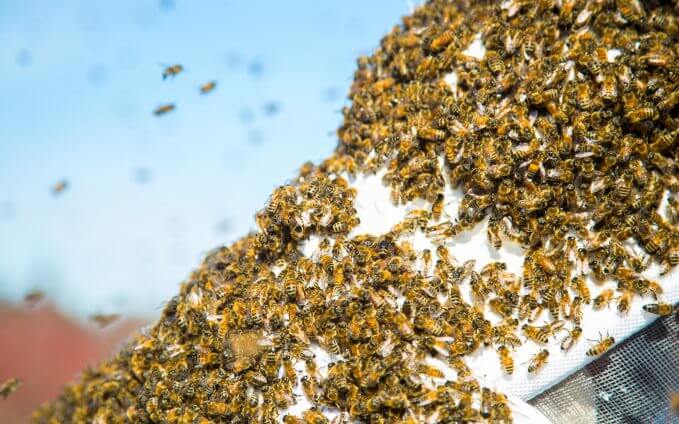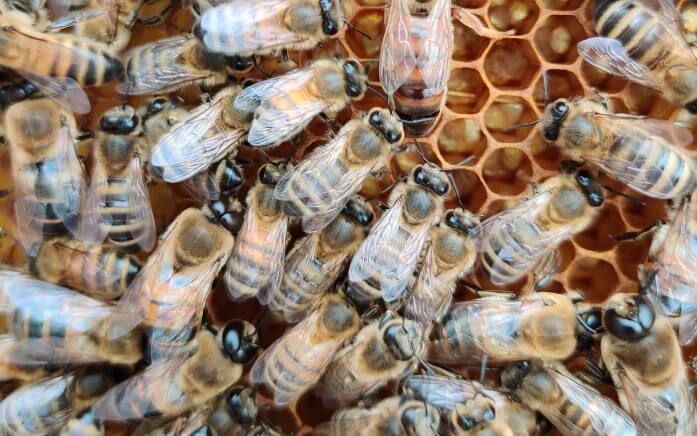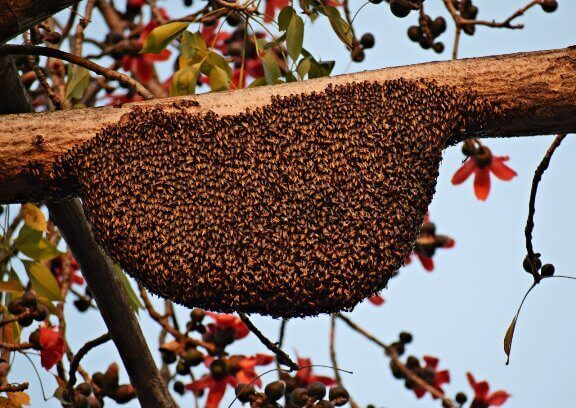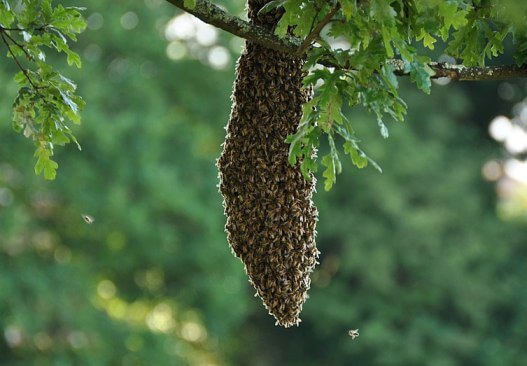You and I talk and communicate through words. That is our language, and we manage to convey information to one another through the use of sound and hearing.
Bees, on the other hand, communicate through the sense of smell. The queen bee releases pheromones into the air, which spread very rapidly over a significant area, compared to her size.
Now the worker bees who’ve been as busy as a bee (ha!) know where the queen is, and that it is time to return to her.
To answer the question in the title, we first need to understand what does “swarm” mean, and when do bees start swarming.
Quite simply, a group of bees is called a swarm.

What happens when bees swarm?
Now, there are two kinds of bee swarms:
- permanent, and
- transitional.
A transitional bee swarm occurs when the hive is moving location with the queen.
This happens the most frequently when the hive is looking for a place to nest for the winter.
In this case, the entire hive moves with the queen, and the workers have an innate feeling of being the queen’s protectors.
Because they want to protect their queen, the bees will surround her while moving because think about it: they are exposing their main source of hive reproduction when they move the hive.
As for the question about what time of day do honey bees swarm, the answer is late afternoon, when temperatures are high and the humidity is low.
Bees tend to like the warm weather and are, therefore, the most active during those times.
A permanent swarm occurs when the hive reproduces — yes, the hive reproduces too!

Hive reproduction? Huh?
Yes, so picture this: you walk outside, and you see bees swarming ground in the springtime.
Now, the sight of ten or twenty thousand bees flying about in a playground may scare some people — I know it scared me the first time I saw one.
Your first urge may be to run and hide, or to exterminate what you perceive to be a threat.
You don’t need to do either of those things, because the only thing the swarm is interested in doing right now is finding a new home for themselves.
So why does this happen? Why does a hove need to split into two? Isn’t there safety in numbers for the insect world?
Valid questions, which I’ll attempt to answer now. First off, when you see bees swarming, it’s very likely to be honeybees swarming, as they are the kind of bees that swarm the most often.
These bees will often break off into a “hive swarm” that will later turn into a new hive. Let me walk you through the process of how a hive reproduces.
So, in the summer, a healthy bee colony will contain anywhere from 50,000 to 80,000 bees, depending on the amount of available natural resources.
However, when the numbers of bees start to grow much beyond that, the size of the hive becomes so large that the queen’s pheromones have difficulty reaching all members of the hive.
When that happens, not all bees will receive the instructions and updates that the queen sends out, plunging the hive into chaos.
And, as you know by now, the backbone of a beehive is discipline and organization.
Having a large section of your workforce not doing what they’re supposed to can be disastrous for the hive.
It is at this point that a new, virgin queen bee is “raised” by the hive. She will remain behind with some of the workers and drones, and the original queen will fly off to look for a new nesting site.
The actual split
Now assume that we have one very large, overpopulated hive. You will notice bees suddenly swarming about, and I’ll explain why this happens.
Now, a beehive takes a significant amount of time to get “overpopulated” per se, so we can safely assume that an overpopulated hive has an aging queen (this is indeed usually the case).
As the queen gets older, her pheromones get weaker. Couple this with the oversizing of a hive, and it becomes increasingly difficult to spread the pheromones where they need to be.
There is a certain group of worker bees dedicated exclusively to feeding the queen. They sense this “depreciation” in the pheromone quality and quantity and cut back on the queen’s diet as soon as that happens.
The queen will then lay a few more eggs over the next few days, including the egg that will birth the new queen.
After this, her worker bees start stocking up on honey from their reserve stockpile (remember, they are leaving behind a fully functioning nest that is probably filled with honey).
Naturally, they leave a good amount of honey so that the bees that stay behind will not starve.
The original queen bee then proceeds to leave the old hive, along with the majority of her workers.
The group leaves the hive in search of new nesting grounds, and this process is what is known as swarming.
That is why we say not to fiddle about with even a seemingly empty beehive in a tree because it could have an unhatched or undeveloped queen which are the remnants of a larger hive.
What happens next?
Outside of the process of swarming, it is a very rare occurrence for the queen bee to leave the hive. Her main purpose is to lay eggs and occasionally, care for larvae.
As such, the wing muscles of a queen bee are extremely underdeveloped when compared to say, worker bees who fly about every single day.
As a result, the queen bee cannot fly nearly as far as the other bees.
Because the other bees will not go anywhere without their queen whilst in a swarm, the swarm doesn’t move very far in one go.
That is why the swarm will rest on a tree branch or other surface when the queen starts to get fatigued.
You will see a mass of bees swarming on the ground, on a tree branch, or rock when this happens.
The queen will be in the center of the bees, so as to protect her from the elements and predators.
In the case of a large hive, the mass of bees can be as big as a basketball!
While the swarm is resting, scout bees are constantly being sent out to look for possible new nesting sites for the swarm to make their new hive.
If a scout bee finds a suitable location, it will quickly fly back to the rest of the swarm and let them know that a place has been found.
The swarm will then rapidly move to that location and set up shop in their new home and resume their day-to-day activities.

But what about the original hive?
Don’t you worry about the old hive?
It contains a sizeable number of worker bees and the newly hatched queen bee, along with the young bees that will go on to repopulate the hive later on.
The worker bees who stay behind completely switch their loyalties over to the new queen, and begin the process of setting up their new (but old) hive all over again.
The old hive still has a decent stockpile of honey and other resources that the bees would need, so there is no pressure as such for the hive to get up and running immediately.
This allows the queen bee to ease into a routine and get accustomed to her “royal” duties.
What time of year / what time of the month do bees usually swarm?
I’ve had countless people ask me what month do bees swarm, but the truth is that there are too many variables involved to give you a black and white answer.
Well, most swarming activity will take place between the months of April through May, provided that that is not the rainy season where you live.
No bee species will swarm during the rain, and they like to move about only in pleasant, sunny weather.

Swarm of bees in my tree: image source: CC BY-SA 3.0 and Nilfanion
Other interesting tidbits
- When attracting honey bee swarms, beekeepers will often lay out sugar water to entice the swarm into their hives.
- If you find bees swarming around your house, the best thing to do is wait. The swarm will most likely move on because they don’t like human interference.
- Bee swarms are not usually dangerous towards humans, because when the bees leave their hive they are so laden with honey that it is difficult for them to use their stingers.
- You may often see bees left behind after a swarm. Beekeepers usually leave boxes there for the scout bees, or else the bees will return to their old hive and continue to live there.
- In case of multiple queens hatching during the split, the new queens will fight to the death with the fittest one taking over the maintenance of the colony.
In this manner, one burdening and overpopulated hive splits into two completely independent colonies that will probably split into more colonies further down the line.
We desperately need this, because beehive populations and the bee population, in general, have been declining at an alarming rate in the past few decades. Read here more: Why are bees important
As we all know, without bees life on earth would most likely perish, so there really is no need to exterminate a swarm.
In case the swarm decides to nest in your house, the smartest thing to do would be to call a local beekeeper to relocate them.
Know about: